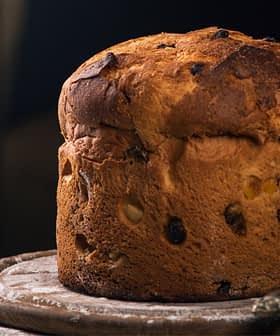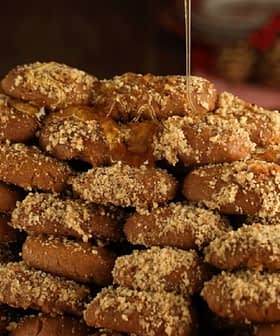New Cake Mixes Challenge Conventional Baking Wisdom
Flour & Olive’s cake mix made for baking with extra virgin olive oil won a gold medal at the Sofi awards. Founder Estelle Sohne believes the win is a victory for the olive oil industry, as it showcases the health benefits and flavor profiles of using olive oil in baking.
A cake mix made to be baked with extra virgin olive oil won a gold medal at the Specialty Food Association’s Sofi award for baking mixes.
“I see this Sofi win as being a win for the olive oil industry, not just for my company, because the cakes are blind tested by culinary professionals against other desserts,” said Flour & Olive founder Estelle Sohne.
This is a collaborative product. I never wanted the cake mix to stand alone because the entire goal is to showcase olive oil’s diversity.
Flour & Olive sells four types of cake mixes. The company also provides ingredient lists for more than 70 cakes and detailed instructions for home bakers to follow for each one.
Extra virgin olive oil used to be considered a less-than-ideal replacement for butter in baking. Since olive oil mainly comprises monounsaturated fats while butter is almost entirely saturated fat, olive oil was thought to be unable to achieve the same textures as butter.
See Also:Cooking With Extra Virgin Olive OilHowever, this has changed as chefs and home cooks explore new ways to harness extra virgin olive oil’s health benefits and flavor profiles in baked creations.
Regina Woods, the culinary director of Dos Olivos Market, has been baking extra virgin olive oil-forward cakes for about a year now. “Cater to the olive oil,” she said. “You’ll have a different flavor profile than a butter cake.”
“You get a lighter texture from the olive oil because butter is very dense, and it’s a richer fat,” Woods added. “But olive oil provides this lightness and adds a lot of air into the cake if you whisk it nicely.”
For her part, Sohne said the Sofi award proves that olive oil is a healthy alternative to butter that can also achieve superior texture and flavor.

Estelle Sohne’s flagship cake recipes
“When you talk about baking with olive oil and the challenges that pose, it’s a matter of perspective,” she said. “If you think it’s impossible, you’re not going to try very hard, or you’re going to take a butter cake recipe and try to replace the butter with olive oil. That does not work.”
While Sohne thinks it may be best for beginners to bake with delicate extra virgin olive oils to avoid pronounced bitter and spicy flavors in the cake, she believes olive oil cakes can win over the skeptics.
“The advantage of olive oil is that it’s a healthier fat and can carry other flavors,” she said. “I think that there’s a blind spot around olive oil, that it’s the savory Mediterranean oil when actually, it’s such a versatile oil that can work with the existing flavors of other cuisines.”
Woods takes a different approach to selecting olive oil for cakes. She favors robust extra virgin olive oils with citrus notes to add complexity to her citrus-flavored cakes. “You want a robust olive oil; that way, it shines through the baking process,” she said.
Sohne’s inspiration for Flour & Olive came while visiting a supermarket and brainstorming ideas to begin her own company based around a food product.
“I wanted to start my own business, and I went down a baking aisle,” she said. “I saw traditional American cake mixes on one side and these international olive oils on the other. I decided to try to make international cakes using these olive oils.”
Sohne spent three years perfecting universal cake recipes (although there are alternative recipes for vegan cakes). She followed a near-scientific approach, removing one ingredient at a time to see how each affected the cake-baking process.
“It was very slow going, but it allowed me to increase how good the cakes were incrementally,” she said. “I must’ve baked over a thousand cakes.”
The preparation begins with an electric mixer beating the eggs for three to five minutes at high speed.
See Also:Spanish Baker Launches Olive Oil-Based Pastry Range“Then you drizzle the extra virgin olive oil, add the wet ingredients and the cake mix,” she said. “Some recipes require stirring, and some require topping, but it’s a systematic set of directions that are uniform throughout the cake mixes. They’re very approachable to make.”
Sohne said achieving the desired texture involved meticulous adjustments to the leavening agents used in the cake mix and a thorough process of determining the precise amount of each ingredient.
Conversely, Woods mixes the dry and wet ingredients separately when she bakes an olive oil cake from scratch, adding the extra virgin olive oil at the end.
“Essentially, one-third of my recipe is the olive oil,” she said. “I mix zest, buttermilk and egg. After, I add the olive oil to get those flavors to meld, then slowly sift in the flour.”
Next, she recommends folding – gently combining lighter and heavier mixtures to retain air – at the very last minute to fully disperse the olive oil into the cake.
Finally, Woods bakes the cakes for longer at lower temperatures “to hold the sanctity of the olive oil and keep it from getting to very high temperatures, which changes the flavor and texture of the cake.”
Instead of baking at 350 ºF (177 ºC) as she would with a butter cake, Woods turns down the dial to 300 ºF (149 ºC).
Back in her home kitchen, Sohne said once she was convinced that her recipe could provide consistent results, she sent cake mixes, ingredient lists and baking instructions to her friends and family.
After receiving plenty of positive feedback and confirmation that the recipes worked, she launched the product, selling it online, in specialty stores and in collaboration with some producers and importers, including McEvoy Ranch, Oil & Vinegar and an Argentine extra virgin olive oil importer.
Sohne does not recommend any single extra virgin olive oil producer of variety. Instead, she believes Flour & Olive’s cake mixes should allow the consumer to experiment with different olive oils and find the best ones that suit their tastes.
“This is a collaborative product,” she said. “I never wanted the cake mix to stand alone because the goal is to showcase olive oil’s diversity.”
“These cake mixes rely on partnerships with olive oil producers and retailers that sell olive oils to pair our mixes with olive oils in a very open-ended way,” Sohne concluded.









